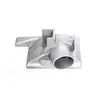Mobile:+86-311-808-126-83
Email:info@ydcastings.com
ss cf8m
Understanding SS 316L and CF8M Stainless Steels A Comprehensive Overview
Stainless steel is renowned for its corrosion resistance, strength, and versatility, making it a popular choice across various industries. Two common stainless steel grades that often arise in discussions are SS 316L and CF8M, both of which derive their properties from their unique compositions and structures.
SS 316L A Low Carbon Variant for Enhanced Corrosion Resistance
.
One of the key benefits of SS 316L is its ability to withstand high temperatures while maintaining its structural integrity. This makes it ideal for components exposed to extreme heat, such as those found in the pharmaceutical and food processing industries. Furthermore, the low carbon content minimizes the risk of intergranular corrosion, making SS 316L particularly suitable for welded structures.
ss cf8m

CF8M The Foundry Alternative
CF8M, on the other hand, is a cast stainless steel alloy that corresponds to the ASTM A351 standard. It is often referred to as austenitic stainless steel and has a composition similar to SS 316, typically containing around 17% chromium, 11% nickel, and 2-3% molybdenum. CF8M is primarily used for casting applications, particularly in valves, pumps, and fittings.
The primary difference between SS 316L and CF8M lies in their manufacturing processes SS 316L is wrought and formed into sheets, bars, and other shapes, while CF8M is specifically designed for casting. This difference affects the material properties and applications. CF8M is known for its excellent strength and durability, making it suitable for high-pressure and high-temperature applications.
Conclusion Choosing the Right Material
When selecting between SS 316L and CF8M, considerations such as the application, environmental exposure, and fabrication method are crucial. Both materials offer remarkable resistance to corrosion and performance under challenging conditions. Understanding their distinct properties helps engineers and manufacturers to make informed decisions, ensuring longevity and reliability in their applications.
-
Why Should You Invest in Superior Pump Castings for Your Equipment?NewsJun.09,2025
-
Unlock Performance Potential with Stainless Impellers and Aluminum End CapsNewsJun.09,2025
-
Revolutionize Your Machinery with Superior Cast Iron and Aluminum ComponentsNewsJun.09,2025
-
Revolutionize Fluid Dynamics with Premium Pump ComponentsNewsJun.09,2025
-
Optimizing Industrial Systems with Essential Valve ComponentsNewsJun.09,2025
-
Elevate Grid Efficiency with High-Precision Power CastingsNewsJun.09,2025











